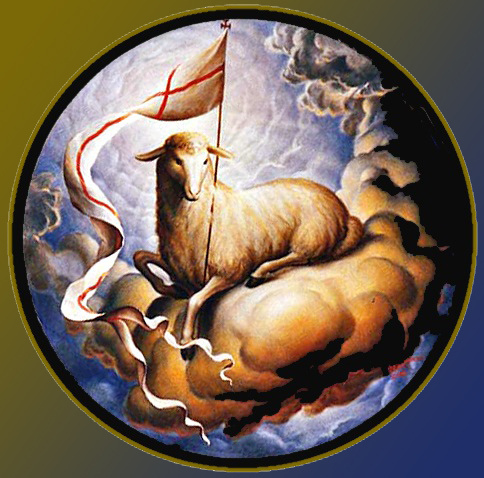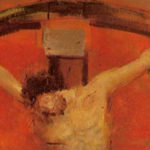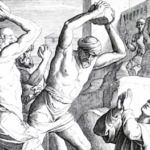We run our website the way we wished the whole internet worked: we provide high quality original content with no ads. We are funded solely by your direct support. Please consider supporting this project.

The Key to Understanding Revelation
The most important key to interpreting John’s violent imagery is found in the heavenly throne room scene in chapters 4-5. (For the first entry in this series on the violence in Revelation, click here.) This throne room represents heaven’s perspective on events that are occurring on earth, which is contrasted throughout Revelation with the false perspective of the “inhabitants of the earth” (8:13; 11:10; 13:8, 12, 14; 17:2). The only real battle that is waged throughout Revelation is a battle between truth and deception. It is, more specifically, a battle between the truth that the Lamb’s slaughtering was victorious and the lie that it was the Lamb’s defeat.
John invites us to see the truth by allowing us to witness the drama that is unfolding in the heavenly throne room. Here we find a mysterious sealed scroll, which contains the secret that Revelation unveils. The drama of this scene reaches a pinnacle when someone raises the question: “Who is worthy to break the seals and open the scroll?” (5:2). John weeps when no one is found worthy (5:4). How long before we learn the secret of the role that Jesus’ martyrdom plays in God’s victory over evil?
The answer is finally brought forth when John hears “one of the elders” in the throne room declare that “the Lion of the tribe of Judah, the Root of David, has triumphed,” and he is therefore worthy “to open the scroll and its seven seals” (5:3-5). This image represents the kind of enemy-slaying Messiah most first century Jews had been hoping for. But, surprisingly enough, when John looks to see this mighty messianic Lion, he instead beholds a little lamb that had already been slaughtered (5:6)!
Yes, John is saying, the Lion of the tribe of Judah has “triumphed,” but he triumphed not by violently slaying his enemies: he triumphed by becoming a slain little Lamb who offered up his life on behalf of his enemies. And yes, Jesus wages war with the aggression of a Lion, but the power that he aggressively wields is the Lamb-like power of self-sacrificial love that was perfectly manifested on the cross. In this way, John has transformed an image of power and domination into an image of vulnerability and nonviolence.
It is hard to overstate the importance of this remarkable symbolic transformation for our interpretation of Revelation. John’s transformation of the Lion of Judah into the sacrificial Lamb constitutes the climactic turn that anchors most of John’s other symbolic reversals. Once the Lion has been revealed to be the Lamb, we never again find Christ referred to as a Lion, though he’s referred to as the Lamb twenty-seven more times. Indeed, it is not an overstatement to say that the rest of the book of Revelation is simply an unfolding of the Lamb-like victory revealed in Revelation 5 and depicted (from a different angle) in Revelation 12. The remainder of Revelation, in other words, is an apocalyptic-like expression of the heavenly truth — spoken against all lies to the contrary — that by means of Jesus’ sacrificial death and the faithfulness of his followers, the “kingdom of the world has become the kingdom of our Lord and of his Messiah” (11:15).
Photo credit: Waiting For The Word via Visualhunt / CC BY
Category: General
Tags: Book of Revelation, End Times, Jesus, Violence
Topics: Biblical Interpretation
Related Reading

Podcast: Could Jesus Have Sinned? (part one)
Greg considers the nature of temptation and the temptability of God. http://traffic.libsyn.com/askgregboyd/Episode_0114.mp3

What is the Kingdom of God (Part 1)
We all know what the Kingdom of God is, right? But this is precisely the problem. Since we are all to a large extent products of our culture, what seems obviously true and right to us will be at least influenced, if not determined, by what seems obviously true and right to our culture. This,…

Grieving
I woke this morning to the news of the shooting death of Philando Castile by a police officer just a few miles from my home. He was pulled over because he had a broken tail light and he ended up shot to death. This comes on the heels of the Alton Sterling shooting which is…

Why Did Jesus Die on the Cross?
If asked why Jesus had to die on the cross, most Christians today would immediately answer, “To pay for my sins.” Jesus certainly paid the price for our sins, but it might surprise some reader to learn that this wasn’t the way Christians would answer this question for the first thousand years of Church history.…

Don’t Be a Functional Atheist at Christmas
All of us raised in Western culture have been strongly conditioned by what is called a secular worldview. The word secular comes from the Latin saeculum, meaning “the present world.” A secular worldview, therefore, is one that focuses on the present physical world and ignores or rejects the spiritual realm. To the extent that one…

Friday Lights: The Bee
Ever heard of The Babylon Bee? It’s a satirical site, sort of like The Onion for Christians. Several of our readers pointed out this site to us, and we loved this entry on an adult coloring book of the imprecatory psalms. It forces you to think through the ways we uncritically accept the violence of some…
